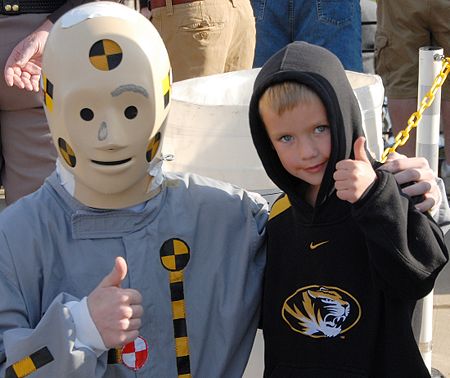Category:907 Traffic Safety: Difference between revisions
mNo edit summary |
m Updated website link for increased security |
||
| Line 59: | Line 59: | ||
|colspan="2"|[http://wwwi/intranet/DevelopingSafetyCulture_3.wmv Developing MoDOT's Safety Culture] | |colspan="2"|[http://wwwi/intranet/DevelopingSafetyCulture_3.wmv Developing MoDOT's Safety Culture] | ||
|- | |- | ||
|colspan="2"|[ | |colspan="2"|[https://epg.modot.org/documents/132_Mowing_Safety.wmv Mowing Safety] | ||
|- | |- | ||
|colspan="2"|[[media:132 Asphalt Operations.wmv|Asphalt Operations]] | |colspan="2"|[[media:132 Asphalt Operations.wmv|Asphalt Operations]] | ||
Revision as of 07:49, 27 October 2021

MoDOT is committed to providing a safe transportation system that does not compromise the well-being of its employees or customers. A large part of this commitment includes researching and implementing engineering strategies to continually improve traffic safety on all Missouri roadways. In order to provide the greatest benefit, MoDOT has focused on reducing fatalities and serious injuries that result from more severe crashes. In addition to focusing on severe crashes, MoDOT has also began implementing a systemic approach to safety improvements. This approach acknowledges that while severe crash locations tend to be random, severe crash types can generally be predicted. For example, while future crash locations along a specific highway cannot be known, data from prior years can suggest that crashes in which a vehicle left the roadway are common. Therefore, instead of only making improvements at specific locations with crash history, improvements, such as rumble strips, can be made along the entire corridor to help prevent or minimize identified crash types.
In 2005, there were over 175,000 traffic crashes in Missouri resulting in 1,257 lives lost and 8,624 serious injuries. Since then, the number of traffic fatalities and serious injuries on Missouri roadways has steadily decreased through 2019. This decline is due, in part, to a variety of engineering solutions such as an improved driving surfaces, bigger and brighter signs, median guard cable, and rumble strips. In 2008, there were approximately 156,000 crashes resulting in 960 lives lost and 6,932 serious injuries.
These Highway Safety efforts in Missouri are guided by the state’s Strategic Highway Safety Plan (SHSP), formerly known as Missouri’s Blueprint. The SHSP outlines emphasis areas for highway safety in Missouri as well as key strategies to be implemented in order to achieve desired results. In addition, MoDOT has developed EPG 907.1 Safety Program Guidelines to help ensure resources are allocated to engineering efforts with the greatest potential to reduce fatalities and serious injuries. These documents along with other resources found below enable smart decisions for beneficial strategies to help more Missouri road users arrive alive each year.

Safety is a pillar of MoDOT’s mission and a key value that is always taken into consideration. It is the department’s priority to provide a transportation system that is safe for all customers as well as keeping our employees safe while performing service to the citizens of Missouri.
MoDOT’s Highway Safety Plan describes how the department will use federal dollars from the National Highway Traffic and Safety Administration (NHTSA) to promote safety throughout the state. These funds are dedicated for educational and behavioral solutions and cannot be used for road and bridge construction.
MoDOT also receives federal dollars from the Federal Highway Administration (FHWA) for safety improvements on the roadway, such as guard cable, rumble strips, warning signs, and other safety features. More information on how MoDOT programs safety dollars on roadway improvements can be found in 907 Traffic Safety.
Finally, the department recognizes construction projects and maintenance activities can include potential hazards for MoDOT staff, contractors, and the traveling public. Information regarding safety precautions for construction inspection can be found in EPG 132.3 Construction Inspection Guidelines for Safety Precautions.
Strategic Highway Safety Plan

Missouri's Strategic Highway Safety Plan (SHSP) is an umbrella document intended to increase coordination, communication and cooperation among state and local agencies, law enforcement agencies, planning organizations, non-profit organizations, researchers, public works departments, educational institutions, businesses, and even families and individuals. The Missouri Coalition for Roadway Safety (MCRS) is the lead group charged with promoting and implementing strategies outlined in the SHSP. The MCRS has regional coalitions in all seven MoDOT districts that help develop plans and activities intended to address targeted crash problems in their respective areas and engage their local communities. The regional coalitions meet on a regular basis to discuss their concerns, review how their countermeasures are working and consider ways to improve their efforts.
Coalition partners are a group of safety advocates representing the education, enforcement, engineering, and emergency medical services areas. Other groups that are common participants or partners of the Coalition include private businesses, elected officials, and victim advocate organizations. For more information on the MCRS, the SHSP, or how to get involved, please visit www.savemolives.com.
Articles in "907 Traffic Safety"
The following 10 pages are in this category, out of 10 total.
9
- 907.1 Safety Program Guidelines
- 907.2 Road Safety Assessment (RSA)
- 907.3 Travel Safe Zones
- 907.4 Missouri Uniform Accident Report
- 907.5 S-HAL
- 907.6 Fatal Crash Reviews
- 907.7 Highway Safety Manual
- 907.8 Speed Trailers Deployed by Others
- 907.9 Safety Assessment For Every Roadway (SAFER)
- 907.10 Complete Streets


